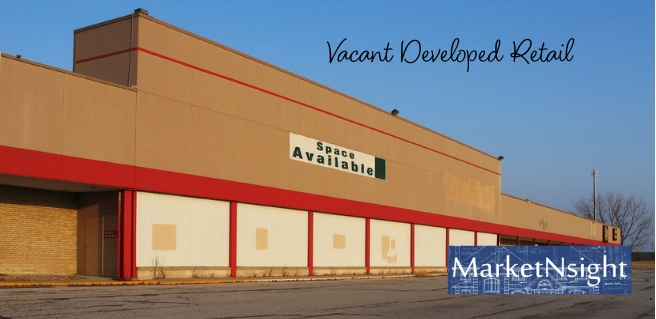Those in the building industry are familiar with the term VDL, or vacant developed lots, which refers to the plethora of foreclosed developed lots that were available at the start of the downturn in 2008. A similar phenomenon is happening in the retail industry today and MarketNsight President John Hunt has coined the phrase Vacant Developed Retail (VDR) to refer to the vast amount of empty (and growing) retail space in America.
“Consumers are shopping differently today – they shop online not at the big box stores, Hunt said. “My Millennial kids will even order toilet paper from Amazon to avoid having to go to a store, and clearly, this isn’t generational, everyone is shopping online.”
A recent article in Popular Science talks about how to remove, reuse and repurpose these giant stores. It sums up the situation by saying, “For decades, these big-box retailers thrived, gobbling up smaller stores that couldn’t compete with the diversity and abundance of wares. But the rise of online retail has changed all that. Instead of driving to a big box store, our purchases come directly to us. As a result, 2017 saw record-breaking 8,700 store closures, including big box stores like Kmart, and more specialty retail outlets like Teavana. The Toys ‘R’ Us shutdown shows things are only getting worse for big box companies.”
According to Hunt, the abundance of vacant retail presents fantastic redevelopment and adaptive reuse opportunities, and some of what is being developed and suggested is innovative, out-of-the-box thinking. Of course, some ideas have not been so great. MarketNsight, along with developers, builders, architects, urban planners and community activists, is looking for creative answers.
In some ways, it is no different from the popular redevelopment efforts that have transformed industrial sites into the live, work and play developments of the past decade. Prime examples of industrial success include Atlanta projects such as Atlantic Station, which was the former Atlantic Steel Mill and Ponce City Market, an adaptive reuse of the historic Sears & Roebuck Company building. At a cost of $300 million, Ponce City Market is a burgeoning success story with retail shops, offices, restaurants and residences.
Other prime examples of projects on the horizon or underway that look like future successes include:
- The city of Memphis recently bought the Raleigh Springs Mall and will redevelop it as municipal facilities including a library, police department precinct and an outdoor skate park arena.
- According to an Atlanta Business Chronicle article, North DeKalb Mall has failed to remain economically viable as consumer preferences have moved away from smaller, traditional enclosed malls in favor of walkable, mixed-use developments. The mall is poised to be the model for the revitalization of distressed and underutilized shopping mall property throughout the region. After renovations, this location will include restaurants, shops, a theater, 150-room hotel, office space, 450 multifamily units, 50 townhomes and a Costco.
- Simon Property Group’s Phipps Plaza Mall in Buckhead is breaking ground on a new mixed-use project that includes redeveloping the Belk department store. The $200 million project will be a 150-room Nobu Hotel and restaurant, 13-story office building and 90,000-square-foot LifeTime athletic facility. The additions are coming after a major renovation that included the additions of apartments and a complete remodel of the building’s façade.
- General Growth Properties is updating its North Point Mall campus in Alpharetta. The project removes the Sears department store and replaces it with a 14-acre, mixed-use project that includes 328 apartments, restaurant space around a 2.5-acre plaza with a multi-use trail system winding throughout and 30,000 square feet of retail. The mall had already converted several stores into leasable office space with common areas for collaborative working. This is part of the City of Alpharetta and its North Point Livable Centers Initiative. The initiative’s aim is to transform the “oceans of parking lots” along North Point Parkway into more pedestrian-friendly development.
- The redevelopment of Underground Atlanta, which originally opened in 1969 as a “city beneath the city,” includes plans for an upscale local grocer, party shop, movie theater, clothing stores and other retailers.
A recent Bloomberg article discusses how large retail giants such as Simon Property Group Inc. and GGP Inc. are spending billions to update centers, adding experiences not found online and reinventing the cavernous spaces left behind by failing department stores. The article continues, explaining there is a growing set of lower-tier malls that have slid too far toward irrelevance to be worth a costly overhaul.
Knowing what to build, where to build it, establishing pricing and working out public-private partnerships will continue to be essential in solving the VDR crisis.
MarketNSight is focused on helping home builders, developers, real estate brokers, investors and banks make smart decisions related to purchasing land and pricing product. Its groundbreaking Feasibility Matrix® systemizes the decision-making process and creates a one-stop-shop for gauging new home community feasibility. To learn more or to schedule a demonstration, visit www.MarketNsight.com.
